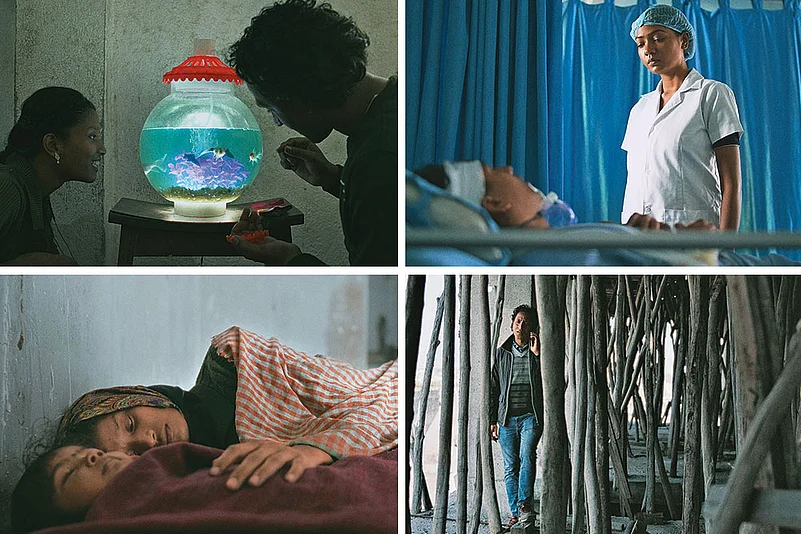This story was published as part of Outlook's 11 November, 2024 magazine issue titled 'Whitewash'. To read more stories from the issue, click here
A fluorescent light illuminates the fishbowl, bringing the colours of its plastic flowers and dancing fishes alive. As the water babbles, the two trace their fingers across the bowl in awe. “Why don’t we find such fishes in our ponds and rivers?” Celestina (Ankita Kerketta) asks. “These are imported fishes,” says Lawrence (Salib Minj). “Don’t they feel trapped?” she wonders. “No,” he says confidently. “It’s been two years; they look happy to me.”
“If we put them in the dam’s water, will they survive?” she inquires. Lawrence smiles. “Won’t they be eaten by the bigger fish?” “Maybe,” Celestina says, “But they will at least get a larger place to swim!”
Celestina and Lawrence, directed by Vikram Kumar, is a film governed by unkept promises and incorrigible desires. Although set in the dusty city of Ranchi, glimpses of Jharkhand’s towns and villages also find their way into its backdrop. This Nagpuri film is a heartwarming ode to the land, its people and the losing battles that are being fought valiantly by them on various fronts. Celestina and Lawrence’s haunting background score by Adrian Copeland and Andy Cartwright add to the lingering sense of love and loss in its visuals.
The film’s narrative is divided into three parts—the first traces Celestina’s journey; the second part follows Lawrence; the third part is on the serendipitous crossing of their paths.
Celestina is a young, unmarried Adivasi woman who has been duped by her lover, a human trafficker. She pursues him to take responsibility for their child, but he traps her in a trafficking case instead. Lawrence is a manager at a construction company, whose aspirations to become a builder have come to a screeching halt with demonetisation. He struggles to hold on to his collapsing relationship with a woman, who is embarrassed by his side-job as a watchman.
At the construction site—whose future is uncertain in the dwindling economy—Celestina and Lawrence meet. In its half-built structure, the space serves as a symbol of their unfulfilled pasts and future hopes. Celestina imagines a group of women singing indigenous wedding songs in this structure, while having to leave her child tied to a brick to work. Lawrence gazes at a couple through its wooden scaffolding, while his own love life comes undone. The building is a metaphor for a home, that could not be.
Dream and reality seep into each other seamlessly in this narrative. Their dreams become important evocative tools that help these characters transition from the state of impasse in their lives to newer beginnings. When Celestina is assaulted by her lover after their confrontation, she dreams of killing her child. However, her mother appears to remind her that it is a part of her own body that she is trying to get rid of. After Lawrence breaks up with his lover, he dreams of her removing his oxygen mask on a hospital bed. Moments of transgression in the dreams manifest into moments of transcendence in the real.
The pace of the film is slow, reflective. It is not set in the sanitised countryside of Bollywood’s rosy imagination. Instead, the director takes great pains to establish the gritty viscerality of its landscape. The construction space, where Lawrence’s father works, is showed in its slow-churning real time. Its monotony breaks through the romanticism that urban spectators often associate with the rural milieu. Another aspect of Bollywood’s illusion that is interrupted in this film is the oft-repeated longing for a simpler, idyllic life of the village. The people who populate this narrative are tired of being stuck in this imagination. Their aspirations are always directed towards the city—even if it translates into a greater struggle for livelihood. “Chalo Dilli chalein” (Let’s head to Delhi) becomes a refrain that mirrors their sense of emptiness in a stagnant world where nothing seems to move forward.
Mainstream Hindi cinema often unhinges the labour from the professions of characters and invisibilises it. Celestina and Lawrence, on the other hand, foregrounds this labour. Lawrence is seen juggling multiple odd jobs to make ends meet. Celestina struggles to find a foothold in any profession because of her toddler. The director intelligently slips in the impact of government policies on the common people, without making an agenda of it. There is also a dialogue between the lure of capitalism and the temptation of rebellion. Lawrence meets his friend Ashish, a Maoist rebel, in the forests and advises him to choose a conventional life. Ashish, in turn, points out the endless cycle of debt and payment delays in which Lawrence is tied up. The dialogue remains incomplete and the questions open, just like the possibilities in their lives.
Celestina and Lawrence is a film that tries to look for poetry in desolation. It doesn’t attempt to redeem its characters; instead, it inhabits an in-between space where there is constant back and forth. They try, they fail and then try some more. In pursuit of an ideal end, they persist in a melancholic transience.
(This appeared in the print as 'Celestial Despair')


















